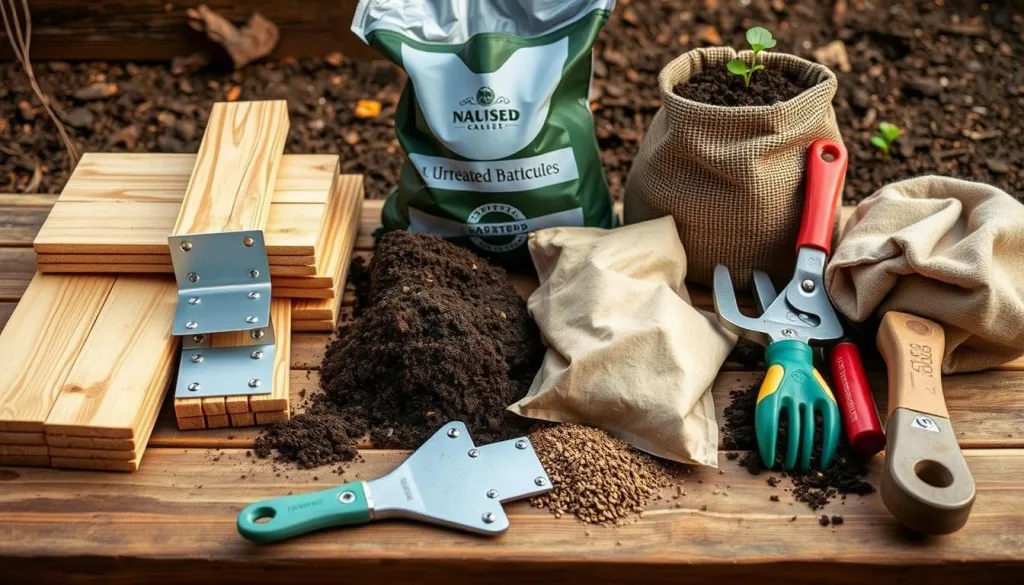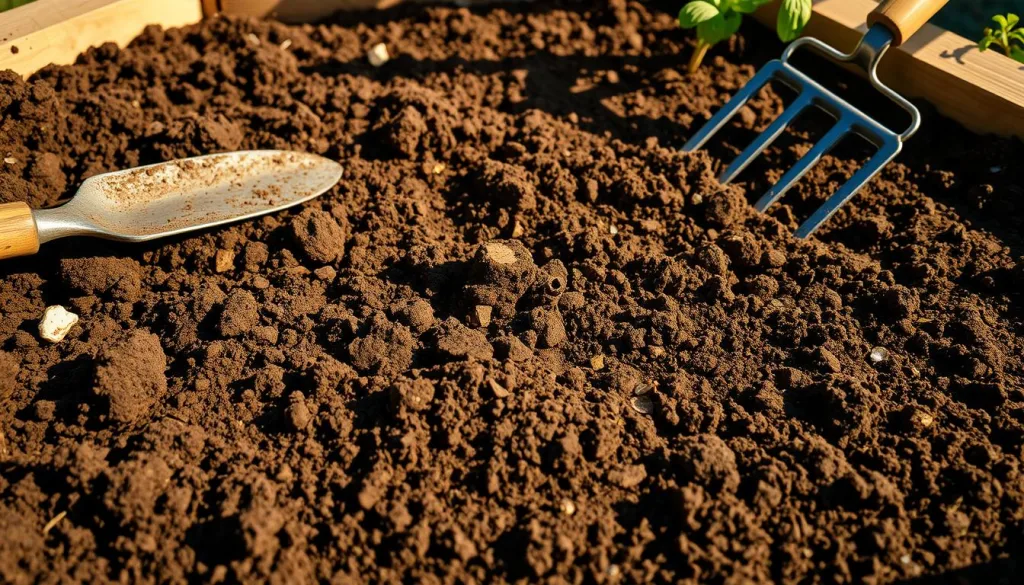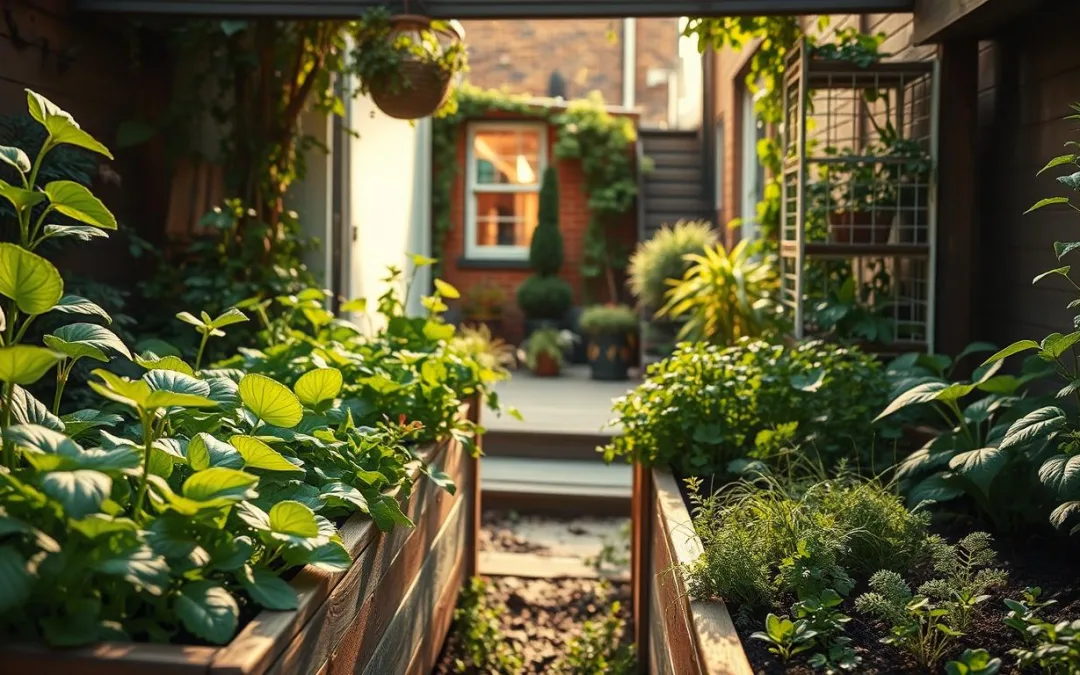Urban gardeners and homeowners with little outdoor space can make their gardening dreams come true. Building raised garden beds is a smart way to grow fresh produce and lovely plants, even in tight spots.
Raised bed gardening is a great chance to grow amazing gardens in small areas. You can use them in tiny backyards, small patios, or tiny urban lots. These structures help you make the most of your growing space.
By using clever design for raised garden beds in small spaces, you can create a garden that’s both productive and beautiful. It’s all about using every inch of space you have wisely.
Key Takeaways
- Raised beds allow gardening in limited spaces with minimal soil requirements
- Strategic design enables maximum plant production in compact areas
- Suitable for urban environments and small residential landscapes
- Provides better soil control and drainage compared to traditional gardening
- Adaptable to various sunlight and space conditions
Understanding the Benefits of Raised Bed Gardening
Urban gardening has changed how we grow plants in small spaces. Raised bed gardening is a key technique for both new and seasoned gardeners. These elevated beds bring big benefits that change the way we garden.
Raised bed gardening lets gardeners control their growing space like never before. Studies from Dawes Arboretum show that raised beds can almost double harvests per square foot compared to regular gardens.
Improved Soil Control and Drainage
Gardeners get big advantages from raised bed gardening’s better soil handling. The soil in raised beds is:
- Looser and more friable
- Less prone to compaction
- Warmer in early spring
- Better draining
Ergonomic Gardening Benefits
Urban gardening with raised beds makes gardening easier on the body. These beds can be made at different heights, helping people with mobility issues. Raised beds also reduce bending and strain, making gardening more comfortable.
Extended Growing Season
Raised bed gardening lets gardeners grow plants longer. These beds warm up faster in spring and stay warm longer in fall. This means gardeners can start planting earlier and keep harvesting later.
Raised beds are not just a gardening method—they’re a pathway to more efficient, enjoyable, and productive urban gardening.
Building Raised Garden Beds for Small Spaces
Creating DIY raised beds for small spaces needs careful planning and creative ideas. Whether you have a tiny balcony or a small backyard, these beds can change your gardening. The trick is to pick materials and designs that use your space well.
Choosing the right materials is key for DIY raised beds. Here are some good options:
- Cedar boards for natural rot resistance
- Galvanized metal for durability
- Recycled materials like wooden pallets
- Concrete blocks for modular configurations
When designing, focus on space-saving sizes. Modular garden bed kits let you adjust your garden to fit your space. Sizes like 2′ x 4′ to 3′ x 3′ are perfect for small areas, giving enough room for plants.
Pro tip: Vertical gardening boosts your growing area. Use trellises or stackable designs to make your beds more productive.
When building, pick materials wisely. Stay away from pressure-treated lumber, which can harm your soil. Choose untreated cedar or safe metal for healthy plants.
Smart gardeners know that limited space doesn’t mean limited possibilities.
Here are the tools you’ll need for your DIY raised beds:
- Measuring tape
- Drill
- Saw
- Landscape fabric
- Chicken wire for pest protection
With careful design, your compact raised beds will be a productive garden. They’ll make the most of every inch of space.
Selecting the Perfect Location for Your Raised Beds
Creating a successful small garden design needs careful planning and the right location. Gardening in small spaces requires thinking about several key factors. This ensures your raised beds grow well and give you plenty of harvests.
Choosing the right spot for your raised beds is important. Several elements will affect your garden’s success. Knowing these can turn even small outdoor areas into great places to grow plants.
Sun Exposure Requirements
Sunlight is essential for any garden. Most popular vegetables need 6-8 hours of full sun daily to grow well. Different plants need different amounts of sunlight:
- Full sun crops (6+ hours): Tomatoes, peppers, squash
- Partial shade crops (4-6 hours): Leafy greens, herbs
- Shade-tolerant crops (2-4 hours): Lettuce, spinach
Space Assessment and Planning
Good small garden design means measuring space carefully. Here are important measurements for placing raised beds:
| Bed Dimension | Recommended Size | Purpose |
|---|---|---|
| Width | 3-4 feet | Easy reach without stepping in bed |
| Path Width | 2-3 feet | Comfortable movement |
| Bed Height | 12-24 inches | Reduce strain, improve drainage |
Accessibility Considerations
Gardening in small spaces means designing for ease of use. Make sure your raised bed layout is easy to get around. Paths should be wide enough for tools and movement. Think about your physical needs and design beds that are easy on your body.
The best location balances sunlight, space, and how easy it is to get to. With careful planning, your raised beds can be a productive and fun place to garden.
Essential Materials and Construction Methods

Building raised garden beds for small spaces needs careful material choice and smart building methods. The right steps can turn a small gardening area into a productive green space.
Wood is the top pick for DIY raised beds. Cedar and redwood are great because they resist rot well. But, they cost more. These woods can last up to 10 years, unlike untreated lumber which lasts 3-5 years.
- Cedar (most recommended for durability)
- Redwood (excellent rot resistance)
- Pine (budget-friendly option)
- Hemlock (cost-effective alternative)
For small space gardening, follow these building tips:
- Choose boards at least 6 inches high for root growth
- Aim for standard dimensions of 4 feet by 6 feet
- Use deck screws for more durable connections
- Ensure proper drainage by drilling holes
Galvanized steel and concrete blocks are also good for DIY raised beds. Steel stock tanks are durable. Concrete blocks can add more planting spaces.
Pro tip: Always check for Forest Stewardship Council (FSC) certification when purchasing wood to ensure sustainable sourcing.
Your raised garden bed’s success depends on the materials, building quality, and design. Tailor it to your small space gardening needs.
Optimal Dimensions and Design for Limited Areas
Designing compact raised beds needs careful planning. You want a space that’s easy to get to and grows well. The right size can turn a small area into a lush garden.
Width and Length Guidelines
Width is key for easy access. Experts say:
- Keep it 3-4 feet wide for easy access from both sides
- Make it 2-2.5 feet wide if it’s against a fence or house
- Make sure you can reach the middle without stepping in the bed
Height Considerations
The bed’s depth affects how plants grow. Optimal depth is 6-12 inches, good for most veggies. Deeper beds (12 inches) are best for:
- Root veggies
- Plants needing more soil
- Better drainage
Space-Saving Configurations
Small gardens need creative solutions. Here are some ideas for compact raised beds:
- Tiered bed systems
- Vertical gardening
- Modular bed setups
- Wall-mounted gardens
With the right dimensions and design, you can make a garden that fits small spaces well.
Soil Preparation and Filling Your Raised Beds

Creating the perfect soil mix is key for a successful raised bed garden. In urban areas, every inch of space is precious. The right soil can boost your garden’s productivity.
Experts suggest a careful approach to mixing soil for raised beds. Here’s a winning strategy:
- 50% high-quality topsoil
- 30% nutrient-rich compost
- 20% organic amendments
The height of your raised bed affects soil needs. Taller beds are great for those with mobility issues, but they need more materials. Most plants do well in 6-12 inches of good soil.
When filling your raised beds, layer organic materials wisely. Start with a base of straw, leaves, and small logs. This method saves money and improves soil health. For more gardening tips, visit holistic health resources.
Pro tip: Water between layers of organic material to help the soil settle and create a stable growing environment.
For urban gardening success, keep your soil in top shape. Add fresh compost after each planting to keep nutrients flowing. This keeps your garden growing well.
Maximizing Growing Space with Vertical Elements
Vertical gardening turns small spaces into green oases. It lets gardeners grow more without taking up more room. This way, even tiny urban spots can grow lots of food.
Vertical gardening cuts down space needs by over 66%. For example, a vining squash plant needs less than 1 square foot vertically. This is much less than the 3 square feet it needs horizontally.
Trellis Systems and Support Structures
Choosing the right support is key for vertical gardening. Use arch trellises or metal frames for climbing plants. These offer many benefits:
- Quick assembly (approximately 10 minutes)
- Durable metal construction
- Weather-resistant design
- Improved air circulation
Climbing Plant Selection
Pick plants that love growing up. Recommended options include:
- Tomatoes
- Cucumbers
- Pole beans
- Peas
- Squash varieties
Space-Efficient Growing Techniques
Here are ways to make the most of vertical gardening:
| Technique | Space Savings | Benefits |
|---|---|---|
| Arch Trellises | Up to 50% reduction | Multiple plant varieties |
| Vertical Staking | 66% space reduction | Increased plant density |
| Wall Mounting | Near 100% ground space saving | Utilizes unused vertical surfaces |
By using these vertical gardening tips, you can turn small areas into green, productive spots. It’s all about planning well and picking the right plants and supports.
Water Management and Irrigation Solutions
Effective water management is key in raised bed gardening, more so in urban areas where resources are scarce. Raised beds dry out quicker than regular gardens. So, it’s vital to have a good irrigation plan for your plants’ health and growth.
When setting up a water management system for your raised bed garden, keep these tips in mind:
- Install a drip irrigation system for precise water delivery
- Use water-conserving techniques tailored to urban gardening spaces
- Implement moisture-retention methods to reduce water waste
Drip irrigation is the best way to water raised beds. It sends water straight to the roots, cutting down on evaporation and disease spread. This method can save up to 50% more water than traditional methods.
Water needs change based on your plants and the weather. Make a watering plan that considers:
- Plant type and water needs
- Local temperature and humidity
- Seasonal changes
Think about using rainwater collection systems to help with watering. These systems can gather about 600 gallons of water per 1,000 square feet. This water can be a green source for your urban garden.
Smart water management turns raised bed gardening into a fulfilling activity.
Plant Selection and Spacing for Small Space Success
To make the most of your small garden, pick plants wisely and space them well. In tight spaces, every inch matters. So, planning carefully is key to a good harvest.
The square foot gardening method turns small areas into productive spots. By dividing your beds into one-foot squares, you can place plants perfectly. This way, you get the most out of your space.
Companion Planting Strategies
Companion planting is great for small gardens:
- It helps plants share nutrients better
- It keeps pests away without chemicals
- It boosts garden diversity
Pro tip: Plant marigolds near tomatoes to keep pests away. It’s a win-win for your garden.
Seasonal Planting Guide
Each season needs its own plan for small gardens. Early-growing plants like Butterhead lettuce (30-40 days) give quick results. Succession planting keeps your garden full of fresh produce.
High-Yield Variety Recommendations
For a successful small garden, choose these high-yielding plants:
- Cherry tomatoes grow well vertically
- Bush beans produce a lot in little space
- Leafy greens give you many harvests
Using these tips, you can turn your small raised beds into a lush, productive garden.
Conclusion
Building raised garden beds for small spaces is a game-changer for urban gardening. It lets gardeners make the most of tiny outdoor areas. Small space gardening doesn’t mean you have to give up on a big harvest.
Creating your own raised beds is a smart move. It costs about $100 per bed to start. You can save hundreds of dollars a year on food. Raised beds are perfect for city gardeners who want to grow food efficiently.
Raised beds improve drainage, cut down on weeding, and make gardening easier. They work great in small backyards or on balconies. They let anyone grow their own food and connect with nature.
Start your small space gardening journey today. Use raised beds to make your urban garden grow and thrive with creativity.
FAQ
What are the primary advantages of raised bed gardening in small spaces?
How do I choose the right location for my raised garden beds?
What materials are best for constructing raised garden beds?
How deep should my raised garden beds be?
Can I create a raised bed garden if I have very limited outdoor space?
What are the best plants for small-space raised bed gardens?
How often should I water my raised bed garden?
What type of soil should I use in my raised garden beds?
How can I protect my raised bed garden from pests?
Can raised bed gardening work in different climates?
Source Links
- How to Utilize Raised Beds for Small Space Gardening – https://extension.unh.edu/blog/2024/04/how-utilize-raised-beds-small-space-gardening
- How to Build Raised Garden Beds – https://www.homedepot.com/c/ah/how-to-build-raised-garden-beds/9ba683603be9fa5395fab90b41bb0da
- Benefits of Raised Garden Beds: Grow a Veggie Garden Anywhere – https://savvygardening.com/benefits-of-raised-garden-beds/
- Raised Bed Gardening Will Keep the Weeds and Pests Away—Here’s How to Get Started – https://www.marthastewart.com/8225103/how-make-plant-raised-garden-bed
- Ultimate Raised Beds For Small Gardens: Try These 5 Raised Options For Compact Corners – https://www.gardeningknowhow.com/ideas-inspiration/ultimate-raised-beds-for-small-gardens
- Easy DIY Raised Garden Bed – Love & Renovations – https://www.loveandrenovations.com/how-to-build-a-diy-raised-garden-bed/
- Build Your Own Raised Beds – Fine Gardening – https://www.finegardening.com/article/build-your-own-raised-beds?srsltid=AfmBOorup0m_wHPF6y11b9GQC3B86WOpaYJp-E4-3HiP2sd24F6oBP7Z
- 5 Best Raised Bed Garden Layouts for Maximizing Your Growing Space – https://www.bhg.com/raised-bed-garden-layout-8682344
- The Ultimate Guide to Picking a Location for Your Raised Bed Vegetable Garden – https://backyard-eats.com/blog/picking-a-location-for-your-raised-bed-vegetable-garden/
- Build a DIY Raised Garden Bed – https://www.lowes.com/n/how-to/how-to-build-a-raised-garden-bed
- Raised Garden Bed Materials: Figure Out Your DIY Setup – https://savvygardening.com/raised-garden-bed-materials/
- How to Build a Raised Garden Bed (On a Budget) – https://rootsandrefuge.com/building-raised-garden-beds/
- What’s the best size for a raised garden bed? | Frame It All – https://frameitall.com/blogs/frame-it-all/best-size-raised-garden-beds?srsltid=AfmBOooBdO0l1M-wnJBDhkyTlOcz2X1a5bBPOyMoyKCkXBElU4mM3zLx
- What is the Ideal Size for a Raised Garden Bed? – https://deepgreenpermaculture.com/2019/04/29/raised-garden-beds-what-size-is-best/
- Small Vegetable Garden Plans and Layouts – https://www.almanac.com/small-vegetable-garden-plans-and-layouts
- How to Choose Quality Raised Bed Soil + Filling Techniques | The Beginner’s Garden – https://journeywithjill.net/gardening/2024/04/03/how-to-choose-quality-raised-bed-soil-filling-techniques/
- How to Build Raised Garden Beds | Thunderbird Disco Homestead – Permaculture Homesteading Blog – https://www.thunderbirddisco.com/blog/how-to-build-raised-garden-beds
- Urban Gardening: Maximizing Growth in Minimal Spaces – https://southernseeds.com/blogs/news/urban-gardening-maximizing-growth-in-minimal-spaces?srsltid=AfmBOop2XDXUG9P2uSk8SBFSlS1SRm1p_RF_AVK8Y1gWLQwDMojXPXmW
- 15 Tips for Gardening in Small Spaces – https://www.epicgardening.com/gardening-small-spaces/
- Grow More In Small Spaces With Metal Garden Arch Trellises From Gardener’s Supply Co. [Review] – https://thecottagepeach.com/blog/best-arch-trellis-gardeners-supply-co-review
- Creating a raised bed garden – https://www.uaex.uada.edu/yard-garden/vegetables/how-to-make-a-raised-bed-garden.aspx
- Raised Bed Gardening – https://extension.oregonstate.edu/catalog/pub/fs-270-raised-bed-gardening
- Guide to Raised Beds: Plans, Timing, Tending | Gardener’s Supply – https://www.gardeners.com/how-to/raised-bed-basics/8565.html?srsltid=AfmBOorpTb-JpVFcNMqNBtEaGet0AvMch5kWIeZRcrDTC_Val7Dobc0k
- How To Space Vegetables In A Raised Bed – https://www.epicgardening.com/how-to-space-vegetables-in-a-raised-bed/
- Building Our Raised Beds • The Prairie Homestead – https://www.theprairiehomestead.com/2017/04/building-raised-beds.html
- DIY Raised Garden Beds – The Maternal Hobbyist – https://thematernalhobbyist.com/diy-raised-garden-beds/
- How to Build Raised Beds for a Micro Smallholding: A Step-by-Step Guide – My Gardening Journey – https://mygardeningjourney.com/2024/09/30/how-to-build-raised-beds-for-a-micro-smallholding-a-step-by-step-guide/


